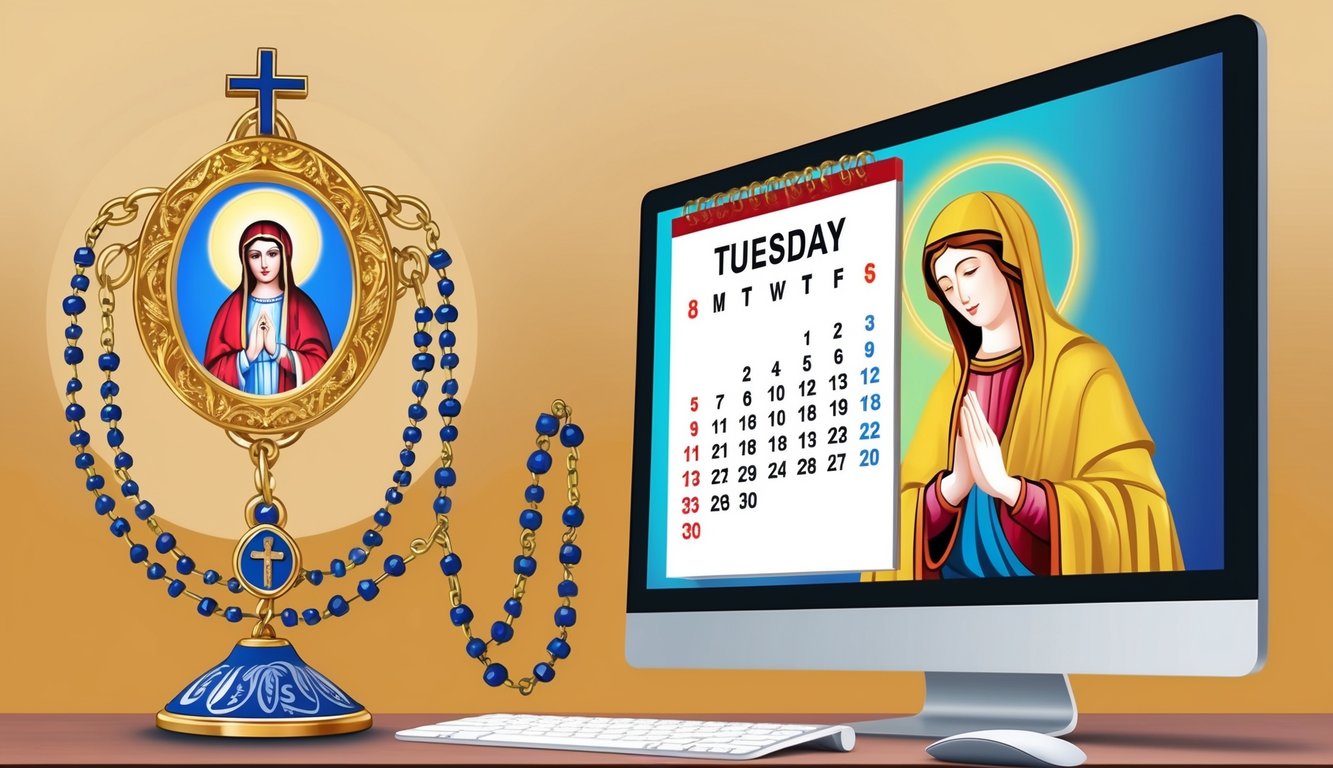Don’t Miss Out On This Unique Astrological Opportunity
Are you tired of spinning your wheels and getting nowhere? Simply put, you’re out of sync: you’re out of alignment with your astral configuration.
But: there’s a kind of map that can help you reclaim your alignment. Think of it as your own personal blueprint to success and happiness: a blueprint that will help you live your most amazing life.
Get started here.
Engaging with a virtual rosary on Tuesdays offers a unique opportunity for reflection and prayer. Joining a global community in reciting the Sorrowful Mysteries online can be done from the comfort of your own home. This modern approach allows you to integrate tradition with today’s technology, creating a personal yet connected spiritual experience.
The practice of reciting the Sorrowful Mysteries holds particular significance on Tuesdays.
These prayers can deepen your spiritual journey by drawing on the trials of Christ.
The virtual rosary provides a flexible way to participate in this profound tradition, making it accessible no matter where you are.
Whether you’re new to the rosary or have been praying for years, joining an online session can enrich your understanding and experience.
Engaging with a virtual community can unify your purpose and amplify the spiritual power of your prayers.
Key Takeaways
- Virtual rosary on Tuesdays involves reciting the Sorrowful Mysteries.
- Online participation enhances accessibility and community.
- Praying the rosary strengthens spiritual connection.
Understanding the Virtual Rosary
The virtual rosary offers a digital way to engage with this traditional practice.
You will find tools like virtual rosary beads and video guides that replicate the experience, making it accessible through screens.
Origins and Importance
The virtual rosary emerged as technology advanced, allowing people to adapt religious practices for digital platforms.
This virtual method gained importance as it provided a way to maintain spiritual rituals remotely, especially during times such as the COVID-19 pandemic.
With origins tied to traditional Catholic practices, the virtual rosary seeks to preserve the essence of saying the rosary daily.
It incorporates scripture readings and meditative reflections, which are central to the conventional rosary.
Whether you use a digital platform or app, the core intent remains the same: enhancing spiritual connection and reflection.
How a Virtual Rosary Works
Using a virtual rosary involves interacting with a screen that displays virtual beads and a main menu to navigate prayers.
As you progress, each bead often corresponds to specific prayers or scripture readings.
Some virtual rosaries include video guides to help you meditate on the mysteries.
This digital format allows you to kneel your avatar and connect deeply, as seen on platforms like Second Life’s Market Place.
The interaction remains personal, echoing traditional practices while offering flexibility to fit into your schedule, whether you’re new to praying the rosary or a seasoned participant.
The Sorrowful Mysteries on Tuesdays
The Sorrowful Mysteries are a set of prayers that focus on the intense moments of Jesus Christ’s suffering.
Each Tuesday, these mysteries guide you through the events from the Agony in the Garden to the Crucifixion, offering deep reflection on the pain endured and the love shown.
First Mystery: The Agony in the Garden
On this day, you reflect on the intense sorrow Jesus felt in the Garden of Gethsemane.
He asked His Father if He might avoid the suffering to come, yet He accepted God’s will.
Pray for strength when you feel overwhelmed.
Imagine the scene where Jesus is in agony, supported by an angel.
The Virgin Mary likely felt a deep connection to her son’s suffering.
This mystery reminds you of the importance of surrendering to divine will even in challenging times.
Second Mystery: The Scourging at the Pillar
This mystery leads you to meditate on the brutal flogging Jesus received at the hands of Roman soldiers.
Pilate ordered this punishment, which was both physically and emotionally exhausting.
When you think about the scourging, recognize the pain Jesus suffered willingly.
It’s a moment to seek forgiveness for human violence and cruelty.
Your prayer here can be a compassionate reflection on those who endure physical suffering today and a reminder of Christ’s sacrifice.
Third Mystery: The Crowning with Thorns
The Crowning of Thorns is a moment of mockery, where soldiers placed a crown of sharp thorns on Jesus’s head, ridiculing Him as “King of the Jews.”
In this mystery, you focus on humility and patience amid ridicule and unjust treatment.
Jesus’s acceptance of this humiliation teaches strength in the face of derision.
Reflect on your life, considering moments you have faced or witnessed unfair judgment, and find inspiration in Jesus’s quiet endurance.
Fourth Mystery: The Carrying of the Cross
As Jesus carries the Cross through the streets to Calvary, He embraces His suffering.
This journey symbolizes the burdens we all bear in life.
Meditate on this passage as He moves slowly under the weight, with His mother, the Virgin Mary, watching in sorrow.
The sight is a powerful reminder of love’s pain.
In prayer, consider your own burdens and the strength it takes to continue moving forward despite them.
Fifth Mystery: The Crucifixion
The final Sorrowful Mystery focuses on the Crucifixion, where Jesus is nailed to the cross, offering forgiveness and salvation for humanity’s sins.
This ultimate sacrifice highlights His boundless love.
In this reflection, you witness the immense sacrifice made for humanity’s redemption.
Visualize the scene involving key figures: Jesus, in a moment of profound forgiveness, entrusts His spirit to God.
Your prayer should focus on the limitless depth of love and forgiveness embodied in this act, urging a deeper commitment to these same values.
The Significance of Prayers and Recitations

Prayers and recitations play a key role in the practice of the rosary.
These elements bring a sense of purpose and rhythm to your experience, enriching your spiritual journey.
Structure of Recitations
A typical rosary session starts with the Sign of the Cross.
You then move into the Apostles’ Creed.
This introductory prayer sets the tone, focusing your mind on the key beliefs of the faith.
The central prayers are the Hail Mary and the Our Father.
You begin each decade of the rosary with an Our Father, followed by ten Hail Marys.
These prayers form the backbone of the recitation, allowing you to reflect on sacred mysteries.
The Fatima Prayer, added after each decade, provides a moment of supplication for mercy.
Each session concludes with the Hail, Holy Queen, which serves as a final tribute.
Using a structured order helps maintain focus and pace, making each prayer feel meaningful. Rosary prayer videos can be handy, offering guidance for newcomers or those seeking more structure.
Meditating on the Mysteries
As you recite each part of the rosary, meditation on the mysteries allows you to engage deeply.
These mysteries serve as a guide to contemplate pivotal events in scripture and life.
The rosary divides mysteries into four categories: Joyful, Sorrowful, Glorious, and Luminous.
Each mystery offers a spiritual insight, encouraging reflection on themes like birth, death, and resurrection.
By pondering these events while praying, you foster a greater connection to the faith.
The act of meditating sharpens your focus, helping to align your thoughts and intentions.
Through this practice, you can find a sense of peace and fulfillment, enriching your spiritual life.
Drawing Spiritual Power from the Rosary

Engaging in the rosary can infuse your daily routine with spiritual vitality and forge a stronger bond with the divine.
It allows you to bring grace and virtue into your life, drawing you closer to God, the Virgin Mary, and the saints.
Benefits in Daily Life
Using the rosary in your daily life helps enrich your spiritual journey.
It offers comfort and guidance during life’s trials and tests.
Through contemplation, it helps grow virtues such as patience and humility, nurturing the soul.
When you meditate on the mysteries of the rosary, you can reflect on key events in Jesus’ life, death, and resurrection.
This reflection provides encouragement and hope for life everlasting.
Engaging with the rosary supports your quest for forgiveness of sins and the strength to live a life in line with heavenly grace.
Connecting with the Divine
Praying the rosary deepens your connection with God and helps foster a relationship with the Virgin Mary and the saints.
Through each bead, you draw closer to the kingdom of heaven, inviting the spirit of grace into your life.
The meditation on the rosary’s mysteries brings a greater understanding of divine love and the selfless acts of Jesus.
This connection provides a pathway to spiritual power, aiding you in evangelization efforts to spread God’s message.
In seeking divine guidance through the rosary, you open your heart to its transformative power, enabling a deeper spiritual understanding and allowing it to bear fruit in your life.
Frequently Asked Questions

This section covers common inquiries about the Rosary on Tuesday, focusing on its mysteries, prayers, and differences from other days.
Resources for guidance are also highlighted.
What are the mysteries prayed on Tuesday during the Rosary?
On Tuesdays, the Rosary focuses on the Sorrowful Mysteries.
These include events from the Passion of Christ such as the Agony in the Garden and the Crucifixion.
This theme invites contemplation on Jesus’ suffering and sacrifice.
How do the Sorrowful Mysteries fit into the Tuesday Rosary?
The Sorrowful Mysteries are central to the Tuesday Rosary.
They are traditionally recited to reflect on the trials Christ endured.
These mysteries offer a way to meditate on themes of suffering and redemption in a structured manner.
Can you explain the sequence of prayers for a Tuesday Rosary?
The sequence starts with the Sign of the Cross and the Apostles’ Creed, followed by the Our Father, three Hail Marys, and a Glory Be.
Each Sorrowful Mystery begins with an Our Father and includes ten Hail Marys, ending with a Glory Be.
What is the significance of praying the Rosary on Tuesday?
Praying the Rosary on Tuesday allows a focus on the Sorrowful Mysteries, providing a chance to meditate on Jesus’ journey to the Cross.
It helps believers deepen their faith by contemplating sacrifice and love.
How does the Tuesday Rosary differ from the Rosary on other weekdays?
While the structure remains similar, the focus shifts to different mysteries.
For instance, the Joyful Mysteries are typically prayed on Mondays and Saturdays, while the Glorious Mysteries occur on Wednesdays and Sundays.
Where can I find resources or guides for praying the Rosary on Tuesday?
You can find guides and resources in various forms.
These include online prayer sites, apps, and virtual communities.
For instance, there is a virtual Rosary in the virtual world of Second Life where avatars can reflect with a visual aid.



